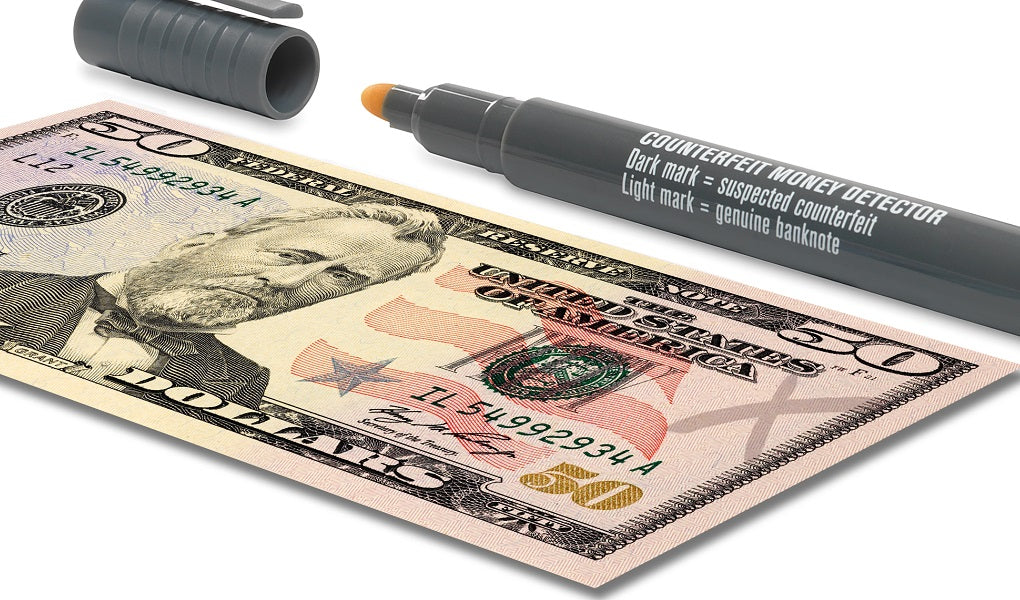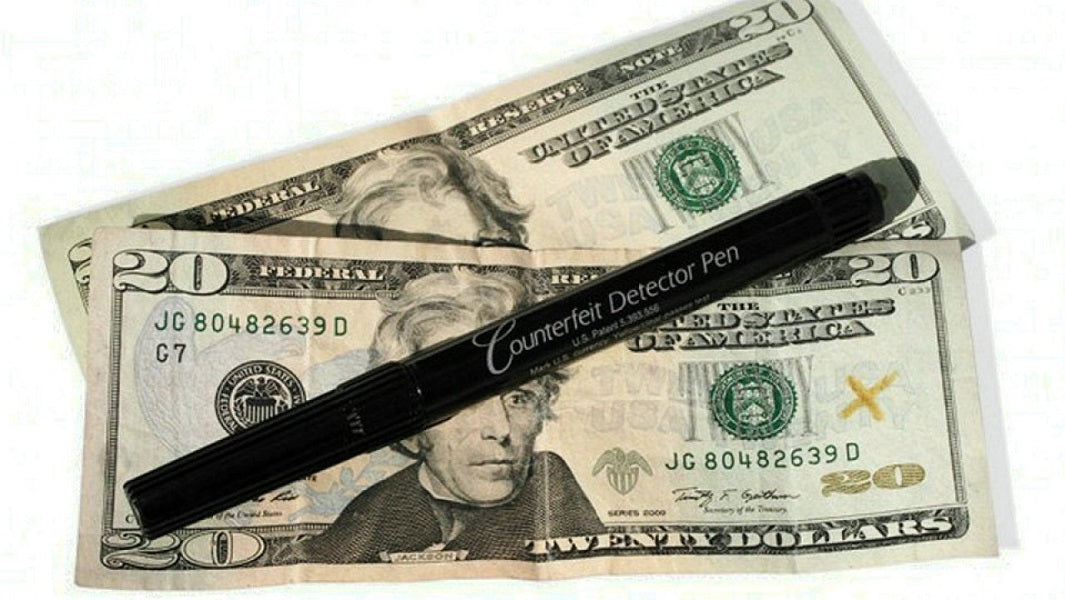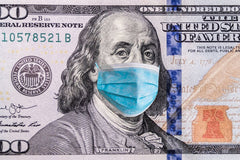Your cart is currently empty.
Free shipping on orders over $50

- Mar, 18 , 20
- 1 comment
Why Counterfeit Pens Are Not Reliable
Contents
Counterfeit bills in the United States constitute a significant problem and a major headache for everyone from the government to the small business owner. The United States Department of Treasury estimates that there is approximately $70 million in counterfeit bills currently in circulation (which equates to 1 counterfeit bill for every 10,000 genuine bills) and that there may be as much as $200 million in counterfeit bills in circulation (which equates to 1 counterfeit bill for every 4,000 genuine bills).
This means that you as an individual are very likely to encounter a counterfeit banknote at least once, and businesses that handle a high volume of cash, such as grocery stores, casinos, shops, and merchants, are even more likely to have to deal with counterfeit bills.
Consider using a bill counting machine to help detect counterfeit bills more effectively, especially if your business handles a high volume of cash.
Security Features in Genuine Currency
To deter counterfeiters, the United States Department of Treasury has implemented a variety of security features into its genuine banknotes which are difficult for counterfeiters to imitate.
For instance, each hundred dollar bill has a security thread that runs vertically to the left of Benjamin Franklin’s portrait. The thread alternates the number 100 and the letters USA and can be seen from both sides of the banknote. Furthermore, when held under UV light, the security thread glows pink.
Another feature is the 3-D security ribbon which is woven into the note (not printed on it) and which changes appearance (from bells to 100s) when the note is viewed from different angles. Other features include a bell in the inkwell that changes color when the note is tilted, a watermark, and ink which changes in color when the note is tilted. These security measures have all been implemented into the new hundred dollar bill, but smaller denominations of bills also possess some of these security features.
The fact that such technologically advanced security measures have been incorporated into genuine United States currency helps to demonstrate how big of a problem the US government considers counterfeiting to be. The Department of the Treasury knows what a financial strain it is to shopkeepers and small business owners. They take their hard-earned gains to the bank to deposit, only to discover that they have been cheated out of what is rightfully theirs by some criminals and their counterfeiting operation.
Consequences of Counterfeit Currency
Counterfeit currency may potentially result in the loss of thousands of dollars in income for a business. If a business does not have a dependable testing procedure for identifying counterfeit bills, it will be easily taken advantage of by counterfeiters and criminals, who can pass hundreds or even thousands of dollars worth of counterfeit bills to a business without anyone noticing. When the business owner goes to deposit that money at the bank, he or she will be in for a nasty surprise.

Thus, any business that handles cash on a regular basis will need to implement a testing procedure for identifying counterfeit bills. This is why the counterfeit detector pen was invented. The cashier will make a mark on any bill he or she deems suspect with a counterfeit pen, and the resulting color is supposed to inform the cashier as to whether or not the bill is genuine currency.
Counterfeit detector pens work in the following way: genuine United States currency is printed on a paper derived from cotton and linen. The paper for genuine currency is thus not wood-based, unlike almost all common printer paper. The wood-based paper contains starch. A counterfeit detector pen contains a solution of iodine. This iodine reacts with the starch molecules that are present in a normal, wood-based paper, to leave a dark brown mark. This black mark indicates that the bill is fake. Neither linen nor cotton fiber will react with iodine, so the mark will not turn black. Thus, a counterfeit detector pen is intended to detect homemade counterfeit bills that a lazy criminal printed on a printer at home with a typical printer paper that one can purchase at a local office supplies store.
Why Counterfeit Detector Pens Cannot Be Relied on
Unfortunately, many counterfeiting operations are far more sophisticated than the home printer operation detailed above. An easy way for counterfeiters to get around the counterfeit detector pen test is to use the same paper on which genuine currency is printed. A counterfeiter can do this by simply bleaching a genuine banknote and reprinting it in a higher denomination (turning a one-dollar bill into a hundred dollar bill, for example). Some more sophisticated counterfeiting operations can even obtain genuine blank currency paper with the proper linen and cotton fiber blend by purchasing it on the black market or from governments which may be unfriendly to the United States.
Also, those counterfeiters who choose to print their counterfeit bills using wood-based paper can still easily get around the counterfeit pen detector test. For instance, the counterfeiter can prepare a Vitamin C solution with ground up Vitamin C supplement tablets purchased from the drug store and apply it to the fake banknote. If such a solution is applied to a banknote, the counterfeit detector pen will produce a false negative (it will indicate that the bill is real when in fact it is a fake note printed on wood-based paper).

Basically, the only counterfeit bills which a counterfeit detector pen will detect are those printed on regular wood-based printer paper. And it does not even detect those 100 percent of the time, since there are easy chemical solutions to get around the pen detection test. It will not detect bills that have been bleached and reprinted with a higher denomination, and it certainly will not detect counterfeit bills that have been printed on paper normally used for genuine currency. Thus, even a properly functioning counterfeit detector pen is, at best, limited in its function of detecting counterfeit bills. It will only detect bills printed by the laziest and least sophisticated of counterfeiters.
Another downside of counterfeit detector pens is that they are subject to misinterpretation. Each counterfeit detector pen maker uses a slightly different proprietary solution in its pens, and they may all react in a slightly different way. A dark brown mark is almost always a positive test for a fake banknote, but the same shade of brown mark may indicate a genuine note for some pens and a fake note for other pens. Furthermore, the solution within the pens is subject to degradation and can lose its effectiveness over time, even in detecting wood-based printer paper counterfeit bills.
The Best Way to Detect Counterfeit Bills
The best way to detect counterfeit bills, then, is certainly not with a counterfeit detector pen. This solution may seem cheap, speedy, and easy, but if you are a small business owner interested in keeping your business in the black, using such a counterfeit detector pen as your only line of defense against counterfeit banknotes will surely cause you pain and heartache in the long run, and cause your bottom line to suffer. Here are some alternatives to counterfeit detector pens for detecting fake banknotes.

First of all, if time permits, a detailed examination by a practiced eye with a magnifying glass is an excellent way of determining if banknotes are fake or genuine. Unfortunately, most cashiers do not have this kind of knowledge regarding banknotes, and even if they do, they usually would not have the time to examine each of the bills in such a detailed manner without aggravating or insulting the customers. But if you hire a cashier who has worked for many years as a bank teller, this may be a practical solution for you.
For most business owners, the most practical and reliable method of detecting counterfeit banknotes is a fake note detector. These machines will implement a variety of elements designed to look for the security features implemented into banknotes.. Some machines also use magnetic thread detection.
These machines may seem expensive, but they are well worth the investment for a small business owner who handles a lot of cash. In fact, most of these machines will pay for themselves just by detecting one or a few counterfeit hundred dollar bills. Some machines also have the ability to detect other official documents or credit cards.
Search
Custom Menu
Recent Post
Archive
- April 2022
- September 2021
- July 2021
- February 2021
- December 2020
- September 2020





1 comment
Julia
Jan 26, 2022 at 05:38Really helpful tips. Thanks for the information.